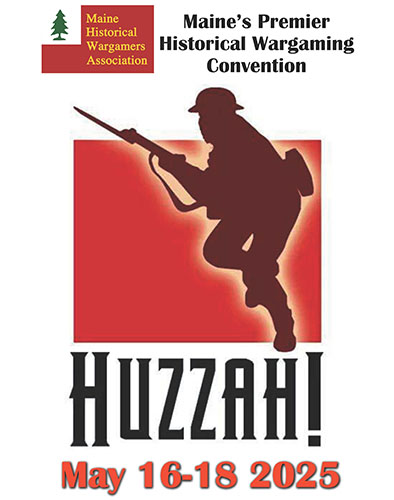 A long time ago in a galaxy far, far away we discussed a War @ Sea scenario depicting the battle at Guadalcanal. This time we have another official scenario to share with all you Axis & Allies Minis fans. The scenario is titled Lions, Tigers, and Bears: The Battle at the North Cape and was composed by Paul Rohrbaugh. You can find this scenario on the official War at Sea website. But, we thought it’d be fun to discuss it with you and share some links.
A long time ago in a galaxy far, far away we discussed a War @ Sea scenario depicting the battle at Guadalcanal. This time we have another official scenario to share with all you Axis & Allies Minis fans. The scenario is titled Lions, Tigers, and Bears: The Battle at the North Cape and was composed by Paul Rohrbaugh. You can find this scenario on the official War at Sea website. But, we thought it’d be fun to discuss it with you and share some links.
Firstly, there are some required equipment that you will need to play this scenario. Take a gander at the list below to make sure you have everything.
- Maps. All of the maps from the Starter Box
- Scenario Rules. Download them, read them (you need the free Adobe Acrobat Reader), and print them.
- Ships and Planes. Allies take 1 HMS Rodney, 1 HMS Ajax, 3 HMS Javelin, and 3 SS Jeremiah O’Brien. Axis roll 1d6 to determine fleet composition. 1-2 is the 1 Bismark, 1 Admiral Graf Spee, and 1 Z 20 Karl Galster. 3-4 is 1 Admiral Graf Spee, 2 U-510, 1 Koln, 2 Z 20 Karl Galster, and 1 FW-200 Kondor. 5-6 is 1 Koln, 3 U-510, 3 Z 20 Karl Galster, 1 FW-200 Kondor, and 1 Ju 87b Stuka.
- Dice, tokens, and other standard accouterments.
The scenario takes place in 1942 so there are some changes to units and their rules. All of those are shown on page 3 of the scenario rules but the most notable affects the Kriegsmarine. If your fleet includes Kondors you are not allowed to use their special ability granting a single range 1 bomb attack per game.
Before we get into more of the scenario I’d be remiss if I didn’t share information on fleet composition. I rolled 100 dice to see the probability of getting Force A, Force B, or Force C for the Axis player. Out of 100 dice here is the breakdown. Fifty of the dice were a 1 or 2. Thirty of them were 2’s and 20 of them were 1’s. Thirty of the dice were a 3 or 4. More exactly 20 were 3’s and 10 were 4’s. Lastly, 20 of the dice were a 5 or 6. Ten dice were 5’s and 10 were 6’s.
I was not a math major nor am I a mathematical genius but even I can make some deductions on that test. Firstly, if you’re the Axis player you are most likely to receive a double edged sword. Half of the time you’ll get the Bismark (representing the Tirpitz…at least until Set 2), the Graf Spee (representing the Scheer) and a Karl Galster. That means half of the time you will have a lot of surface firepower but you are also more likely to experience a tougher game. If you have the Bismark you need to accomplish your other goals while ensuring she doesn’t sink. That’s no mean task.
Next, 30% of the time you’ll have what I consider to be a really strong fleet. One battlecruiser, some u-boats, a cruiser, a bomber, and a couple destroyers isn’t a bad deal. The Allies have no air support but their ships do have anti-air batteries. If you’re thinking of taking that Kondor and killing the Rodney easy as pie you may want to think again. Don’t forget it has 7 dice for AA. In fact, all of the ships are decent at anti-air. Each Javelin has 5 AA dice plus their nifty smoke screen special ability. The obvious target for the quick win are those transports. Naturally, the Allied player should protect the transports with some destroyers.
Lastly, 20% of the time the Axis player has everything and the kitchen sink. There will be two air units that you can either stagger on air missions or send together for the knockout blow. The extra u-boat will be helpful but don’t forget that 3 sub hunters will be on the map for the Allies. The major downside of Force C is the exclusion of big ships. The biggest ship available to the Axis player in this force is a cruiser. The Koln is decent, no doubt about that, but can it really handle a range 4 battleship?
As an Axis player I am most excited by Force B with Force A as a close second. Force A has risks involved due to the Bismark’s appearance but it has some serious hitting power. Force B provides a lot of varied units including my beloved u-boats.
As a means of wrapping up this article I’d like to share the optional house rules. There are three of these rules that can impact the game. They are recommended, by WotC, to be used only for increased realism and/or when players of vastly different experience are battling. One alters the damage roll when firing on a ship larger than yourself and it also removes the 6 = 2 hits rule. Another affects secondary batteries whereby they do less damage in addition. The last increases the lifespan of destroyers by giving all destroyers the Chase the Salvoes special ability.
So, you’ve read all this and you want to know how to win the scenario. That is quite simple really. As the Allied player you need to get as many of your transports, the SS Jeremiah O’Brien, off the map through Row A (where the Axis player setup). It is a sliding scale with all 3 = Decisive Victory, 2 = Moderate Victory, and 1 = Marginal Victory. If you also manage to sink the Bismark, aka Tirpitz, you bump your win up a category. That makes a Marginal into a Moderate and a Moderate into a Decisive and a Decisive into Slaughter Victory. For the Axis player to win he or she must prevent the Allies from winning. Kill all the transports and don’t let the Bismark sink.



Do you have, or can you give me the link, to the first two WAS Scenarios? Thanks
Hi Dane. Thank you for your comment. Prompted by your comment we have two forthcoming articles covering the two other scenarios. The first will debut in less than 24 hours and the other will be available this coming Monday or Tuesday.
Since you were the impetus for this I’m pleased to share the links to the scenarios with you now. Please note the scenarios are PDF files and you need the free Adobe Reader.
WAS Scenario 1: Action Deferred: The Battle of Cape Teulada
https://wargamingforums.com/wp-content/uploads/2008/07/Scenario_WAS1.pdf
WAS Scenario 2: In Harm’s Way: The Battle of Sunda Strait
https://wargamingforums.com/wp-content/uploads/2008/07/Scenario_WAS2.pdf
I hope you’ll check back to read our articles on the two scenarios. Thanks again.
Thank you very Much! Fantastic
Pingback: War at Sea Scenario: Action Deferred » CWF Game Cast
Dane we will be sharing WAS Scenario 4 soon as well. It is the first scenario designed for use with Task Force. Be sure to check back and you’ll see it on the blog. Or, you can always see all our War at Sea articles by going to https://wargamingforums.com/tag/war-at-sea/
I was expecting this game to have historical units for Battle of North Cape.
I did enjoy some of the special rules for the Lions, Tigers, and Bears.
For anyone wanting to use and convert units for the historical Battle of North Cape, I have some recommendations:
Use Prince of Wales as Duke of York. Paint over the camoflage color scheme with a naval light blue gray. Use Australia or Canberra as HMS Norforlk. This unit should be a solid light gray similar to HMS Belfast. War at Sea doesn’t have HMS Sheffield or any other ship in that class yet, so I just omit this unit. Get four Saumerez destroyers and label them Savage, Stord, Scorpion, and the last keep as Saumerez. These were the four S-class destroyers in Force 2 with HMS Jamaica and HMS Duke of York. For the Germans you’ll need five Z-32 destroyers. Take a fine point sharpie and label the bottoms as Z-29, Z-30, Z-33, Z-34, and Z-38. These units accompanied Scharnhorst, but broke off in search of the Convoy. I used 3 to 4 convoy ships with a 4-5 destroyer escort. I don’t believe War at Sea makes the class destroyers that were with this convoy so I just used HMS Javelins and HMS Cossacks for this role.
I play this battle with open ocean except for one island to the North that represents Bear Island. The way I like to play is letting the British player role one die without sharing the results with the other player. Whatever number rolled will represent what turn Force 2 will arrive from the West after the forces on the board have engaged. So if Force 1 and the Scharnhorst begin firing on each other in turn 7 and the die role before the game began was a four for the British player, Force 2 arrives four turns later on turn 11. This is a great way to play because it keeps the Germans focused on the goal of going for the convoys and avoiding Force 1 as long as possible. The British player knows when back-up will arrive while the Germans risk going too far North unable to get back to Norway in the South safely.